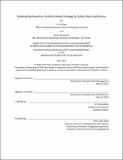Rationalizing Inventory: A Multi - Echelon Strategy for Safety Stock Justification
Author(s)
Chen, Yu-Ta; Alexander, Rohan
DownloadRationalizing Inventory A Multi Echelon Strategy for Safety Stock Justification.pdf (588.4Kb)
Metadata
Show full item recordAbstract
This work presents a multi-echelon inventory optimization model for a manufacturing company to evaluate optimal inventory levels for a selection of products and their sub-components. The guaranteed service model is employed to identify potential improvements in inventory allocation while maintaining service levels. The model's results are compared with the company's current inventory policies to provide insights into the effectiveness of the proposed approach. First, demand forecasting was conducted for the selected products, and the results showed a close match with the company's existing forecasts. Next, a multi-echelon inventory optimization model was formulated using bill of materials, component lead times and standard costs. The model was optimized in Python to minimize total inventory holding cost, with constraints on service level, service time, and bounded demand. The model's output suggested an "all-or-nothing" type of inventory policy, wherein a stage either maintains zero safety stock or holds the maximum permissible safety stock. The results of the model revealed that 54% of the analyzed sub- components do not require any safety stock to be held. Additionally, the model proposes pooling inventory in stage 0, which is the finished product stage. The true financial impact of the model's results is difficult to gauge, because only a small portion of the product portfolio was used in the optimization. Potential areas for future work include investigating the impact of phantom stock removal, applying the stochastic service model to this problem, and understanding the impact of multi-echelon modeling on supply chain resilience. The insights provided in this work can serve as a starting point for manufacturing companies aiming to optimize their inventory policies and better manage their supply chains.
Date issued
2023-09-08Keywords
Supply Chain Management, Modeling